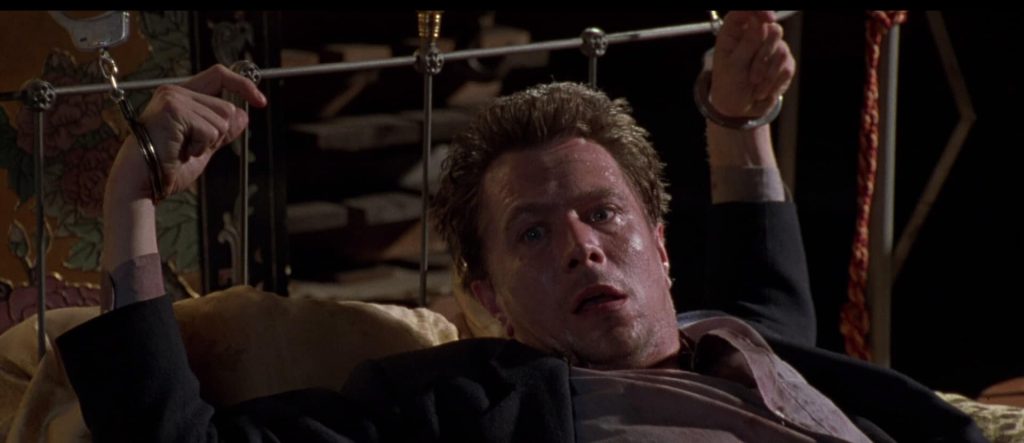If the ‘30s and ‘40s were the golden age of the crime picture, and the ‘70s was its silver age, then the ‘90s must be considered the genre’s bronze age. Throw a dart at any year of that decade and there’s a good chance you’ll land on some memorable, if not necessarily classic, neo-noir. And while many of these films are considered Quentin Tarantino rip-offs, surfacing in the wake of his culture-shifting smash Pulp Fiction and aping his uber-cool, postmodern, pop-culture-obsessed attitude, the truth is that the trend predates his entrance unto the scene.
For one of the starkest examples of this, see Romeo is Bleeding from 1994. Directed by Hungarian-British filmmaker Peter Medak off an original script from Hilary Henkin, the story follows corrupt police sergeant Jack Grimaldi (Gary Oldman), who is tasked by the mob to take out a psychotic Russian hit-woman named Mona Demarkov (Lena Olin). Suffused with dark comedy and a heavy dose of surrealism (much of which comes via nonlinear editing), and splattered with profanity and ultra-violence, Romeo would read, on paper, like a standard derivative QT entry, were it not for the fact that it’s release predates Pulp Fiction by eight months.
(And given that it premiered in the UK in ‘93, it seems hardly feasible it would have been overly influenced by Tarantino’s 1992 debut Reservoir Dogs, either.)
Indeed, Romeo is Bleeding has much more in common with the titles that make up its filmmaker’s pedigrees, including Medak’s darkly violent satire The Ruling Class (1972) and his true-life British gangster saga The Krays (1990), as well as—indeed, especially—Henkin’s script for Roadhouse (1989). Like that classic, Romeo is a wild work of unabashed maximalism, only instead of a double shot of booze, it hits you like a benzedrine rush (with the requisite hazy lulls that come during crash periods).
Medak, along with cinematographer Dariusz Wolski, delivers one artful composition after another (this is the type of picture that everyone took for granted 30 years ago, but which, were it to come out today, would be hailed as a visual masterwork), yet every frame seems to be dripping in grime, flop sweat, semen and, of course, blood. The title, taken from a Tom Waits song, becomes increasingly literalized as our antihero suffers more and more physical damage throughout the course of the story, so that by the last act he looks like a horror-movie version of a hapless Looney Tunes character.
That comparison is more apt than you might expect. Oldman’s womanizing addict is a predecessor to the type of toxic anti-hero we’d see pop up in the next decade (particularly via TV with the likes of Tony Soprano and Walter White) , his main vice being greed—he does the mob’s dirty work in order to continually “feed the hole” (as in, add bundles of cash to an actual hole he’s dug in his backyard). But though he talks about playing both sides against the middle, he’s less Yojimbo and more Elmer Fudd.
Of course, every Elmer Fudd needs their Bugs Bunny, and boy, does that describe Olin’s human tornado of carnal destruction, who sows so much madcap chaos by film’s end that you half-expect the set to come crashing down around her. If Oldman—who at this point in his career was known for playing seedy, dangerous types—is at his unhinged best, Olin is outright feral. To say she steals the film is an understatement: she outright takes it and makes it her bitch. It’s a physical performance in every sense of the word—not only does she wield her body as a weapon in the name of seduction, she actually uses it as a weapon at various points. (During the most impressive set piece, which involves a brutal car crash and Olin’s attempts to extricate herself from the wreckage with her hands cuffed behind her back, the actor performed all her own stunts.)
Great as Oldman and Olin are, this is hardly a two-hander; like pretty much every ‘90s neo-noir, Romeo is Bleeding boasts an absolutely stacked cast, featuring Juliet Lewis, Roy Scheider, Dennis Farina, Annabella Sciorra, Michael Wincott, Will Paton, Ron Perlman, James Cromwell, and David Proval.
What really distinguishes Romeo is Bleeding, beyond the slapstick carnage, is the dreamlike sense of menace that pervades it. In this regard, it seems in line with David Lynch’s style (Mark Isham’s jazzy score, by turns wildly rococo and hauntingly soulful, often recalls Angelo Badalamanti’s work), although like Tarantino, it would be wrong to suggest any overt influence there.
There was something in the water supply during the first half of the ‘90s that saw any number of filmmakers crafting these unnerving, uber-nihilistic, psychosexual crime films, many of which were based on the writings of post-war pulp novelists like Jim Thompson and Charles WIlleford. Though a wholly original script, Romeo is Bleeding has so much in common with their deranged sensibilities that you’d be forgiven for assuming it was adapted from one of their forgotten books.
Generally, the meaner, sleazier, and weirder the crime film, the more critics and audiences hate it. For every Pulp Fiction or Fargo that manages to break through, there are a dozen Romeo is Bleedings, generally savaged upon release and then mostly forgotten, save for in the hearts of cult film fanatics and noir completists. In the case of Romeo is Bleeding, Oldman’s star performance certainly helped keep it from falling into total obscurity, being that he would go on to be one of the most acclaimed and sought-after stars of the next several decades.
But now, 30 years after its debut, it deserves to be rediscovered and recognized as the type of everything-including-the-kitchen-sink noir nightmare that has all but disappeared from screens.
“Romeo is Bleeding” is streaming on several ad-based services, and is also available for digital rental or purchase.

